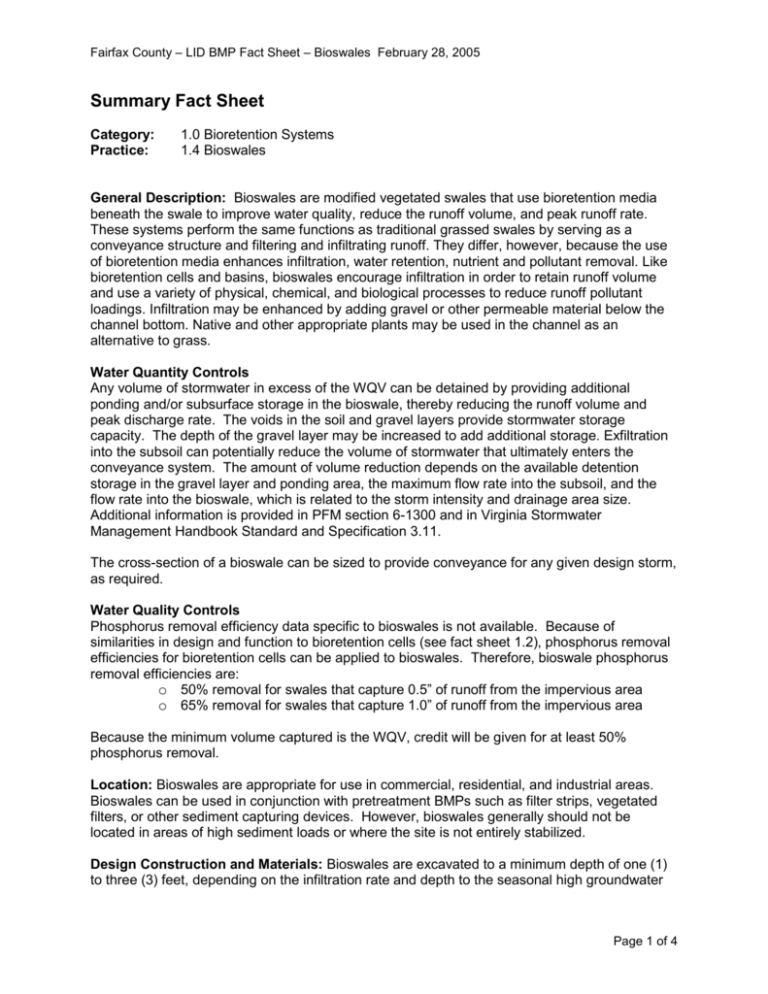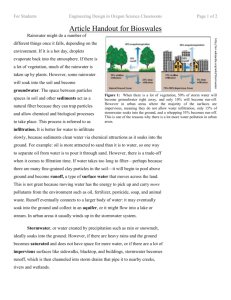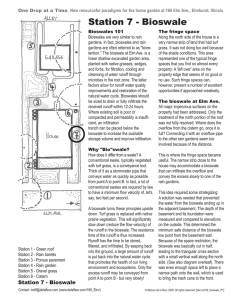X - Low Impact Development Center
advertisement

Fairfax County – LID BMP Fact Sheet – Bioswales February 28, 2005 Summary Fact Sheet Category: Practice: 1.0 Bioretention Systems 1.4 Bioswales General Description: Bioswales are modified vegetated swales that use bioretention media beneath the swale to improve water quality, reduce the runoff volume, and peak runoff rate. These systems perform the same functions as traditional grassed swales by serving as a conveyance structure and filtering and infiltrating runoff. They differ, however, because the use of bioretention media enhances infiltration, water retention, nutrient and pollutant removal. Like bioretention cells and basins, bioswales encourage infiltration in order to retain runoff volume and use a variety of physical, chemical, and biological processes to reduce runoff pollutant loadings. Infiltration may be enhanced by adding gravel or other permeable material below the channel bottom. Native and other appropriate plants may be used in the channel as an alternative to grass. Water Quantity Controls Any volume of stormwater in excess of the WQV can be detained by providing additional ponding and/or subsurface storage in the bioswale, thereby reducing the runoff volume and peak discharge rate. The voids in the soil and gravel layers provide stormwater storage capacity. The depth of the gravel layer may be increased to add additional storage. Exfiltration into the subsoil can potentially reduce the volume of stormwater that ultimately enters the conveyance system. The amount of volume reduction depends on the available detention storage in the gravel layer and ponding area, the maximum flow rate into the subsoil, and the flow rate into the bioswale, which is related to the storm intensity and drainage area size. Additional information is provided in PFM section 6-1300 and in Virginia Stormwater Management Handbook Standard and Specification 3.11. The cross-section of a bioswale can be sized to provide conveyance for any given design storm, as required. Water Quality Controls Phosphorus removal efficiency data specific to bioswales is not available. Because of similarities in design and function to bioretention cells (see fact sheet 1.2), phosphorus removal efficiencies for bioretention cells can be applied to bioswales. Therefore, bioswale phosphorus removal efficiencies are: o 50% removal for swales that capture 0.5” of runoff from the impervious area o 65% removal for swales that capture 1.0” of runoff from the impervious area Because the minimum volume captured is the WQV, credit will be given for at least 50% phosphorus removal. Location: Bioswales are appropriate for use in commercial, residential, and industrial areas. Bioswales can be used in conjunction with pretreatment BMPs such as filter strips, vegetated filters, or other sediment capturing devices. However, bioswales generally should not be located in areas of high sediment loads or where the site is not entirely stabilized. Design Construction and Materials: Bioswales are excavated to a minimum depth of one (1) to three (3) feet, depending on the infiltration rate and depth to the seasonal high groundwater Page 1 of 4 Fairfax County – LID BMP Fact Sheet – Bioswales February 28, 2005 table or bedrock. Deeper excavation can provide for additional storage in the soil or gravel layers. Underdrains are recommended in areas with low subsoil permeability (e.g. compacted or clay soils) or shallow soil profiles. Underdrains must tie into an adequate conveyance system. Observation/cleanout wells should also be installed if underdrains are used. A gravel layer provides temporary storage of stormwater, which will exit through an underdrain (if present) and/or through exfiltration into the subsoil. If an underdrain is present, the gravel layer surrounds the underdrain pipe to minimize the chance of clogging. The excavated area is then filled with an engineered media classified as “sandy loam” or “loamy sand” that typically consists of: o 50% sand o 30% planting soil with minimal clay content, and o 20% shredded hardwood mulch. The swale area is then seeded to provide a mixed plant community including warm season grasses, herbaceous annuals and flowering perennials. The swale must provide for bypass flow into an inlet or overflow weir. Check dams may be used in the swales to act as flow spreaders and encourage sheet flow. Bioswale slopes should be no greater than 5 percent. Low gradient and reduced velocities are critical to ensuring a stable, non-erosive swale. Bioswales typically consist of the following cost components. Item Unit Estimated unit cost (2005 Dollars) Excavation C.Y. $8 - $10 Grading S.Y. $0.10 - $0.15 Bioretention media C.Y. $40 - $60 Filter fabric S.F. $0.70 - $1.00 Gravel (for underdrain trench) C.Y. $30 - $35 8” dia. perforated underdrain pipe L.F. $15 - $20 Seed S.F. $1 - $2 Cost: The cost for a bioswale to treat runoff from ½ impervious acre is comprised of both the installation cost and annualized costs. These cost calculations were based upon a bioswale with a surface area of 900 ft2. A bioswale is assumed to have a lifespan of 25 years, at which point it will be removed and replaced. Page 2 of 4 Fairfax County – LID BMP Fact Sheet – Bioswales February 28, 2005 Item Required Cost per Year (2005 Dollars) 1 2 3 4 5 6 7 8 9 10 Mowing 100 100 100 100 100 100 100 100 100 100 Reseeding / Replanting 100 100 100 100 100 100 100 100 100 100 Installation1 0 … 25 10,000 Remove & Replace 10,000 Total Cost 10,000 Annualized Cost $600 / year (includes replacement in year 25) 200 200 200 200 200 200 200 200 200 200 10,000 1 Developer Cost. Not included in annualized cost. Maintenance: The primary maintenance requirement for bioswales includes routine inspections targeted at maintaining hydraulic efficiency of the channel, the treatment effectiveness of the bioretention components, and a dense, healthy vegetative cover. Maintenance activities should include periodic mowing (with grass never cut shorter than the design flow depth), clearing of debris and blockages, and sediment removal. Reseed bare areas annually. Inspections should also look for erosion along the bottom of the swale channel. Performance and Inspection: To ensure proper performance, visually inspect that stormwater is infiltrating properly and is being conveyed through the length of the bioswale. Water ponding in a bioswale for more than 48 hours may indicate operational problems. Corrective measures include inspection for and removal of accumulated sediments. Backflushing the underdrain is another option. Samples of the bioretention media should be taken in the case of poor infiltration to determine the condition of the media (e.g. clay content). Full or partial replacement of the bioretention media may be required to restore the flow rate through the swale. Alternately, soil amendments can first be applied in an attempt to restore permeability. Perform this inspection: annually in spring, and after extreme events (e.g. after hurricanes). Bioswale Source: Portland BES Page 3 of 4 Fairfax County – LID BMP Fact Sheet – Bioswales February 28, 2005 Links to Additional Information: Fairfax County PFM: http://www.co.fairfax.va.us/dpwes/publications/pfm/6.htm Virginia Stormwater Management Handbook: http://www.dcr.virginia.gov/sw/stormwat.htm#pubs Northern Virginia BMP Handbook: http://www.novaregion.org/pdf/NVBMP-Handbook.pdf New Jersey Department of Environmental Protection, New Jersey Stormwater Best Management Practices Manual, February 2004. Natural Resources Defense Council. 2001. “Stormwater Strategies: Community Responses to Runoff Pollution.” Available at http://www.nrdc.org/water/pollution/storm/stoinx.asp United States Environmental Protection Agency, 2000: Bioretention applications: Inglewood Demonstration Project, Largo, Maryland, and Florida Aquarium, Tampa, Florida. Office of Water, Washington, D.C., EPA-841-B-00-005A U.S. Environmental Protection Agency, 1995: Maryland developer grows 'Rain Gardens' to control residential runoff. Nonpoint Source News-Notes, 42 (August/September) Available at http://www.epa.gov/NewsNotes/issue42/urbrnf.html Page 4 of 4








